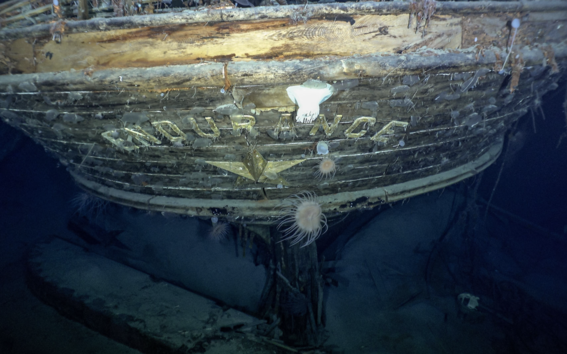Wreck of Ernest Shackleton's ship Endurance found in Antarctica

On the afternoon of Saturday 5 March, the wreck of Ernest Shackleton’s ship Endurance was found at a depth of 3008 metres in the Wendell Sea. Aalto University ice scientist Jukka Tuhkuri was on hand to witness the historic moment.
Professor Tuhkuri is part of the seven-week Endurance22 expedition to Antarctica. He is studying how climate change alters sea ice, and how those changes would affect ice loads encountered by ships. You can read more about his role in the expedition here.
Read Jukka Tuhkuri's notes from 5 March:
Endurance has been found
Endurance, Ernest Shackleton’s ship, has been found. Endurance sank in the Weddell Sea off Antarctica in November 1915, and on Saturday afternoon, 5 March 2022, it was found at a depth of 3008 metres. The wreck is about four nautical miles south of the spot that Frank Worsley, the ship's captain, calculated as the location where it sank. Endurance stands proudly on the sea bottom in good condition. The ship’s name can be clearly seen on its stern, and the wheel is intact. The website of our expedition, endurance22.org, has pictures and video of the wreck.
When Endurance was found, I was on the helipad of SA Agulhas II with John Shears, the head of the expedition. We had just come up from the ice, where I had been collecting samples, but we stayed on the deck to chat. It was a beautiful day; we were looking at the scenery and watching the emperor penguins. John said that it had been a great day and he had a feeling that Endurance would be found soon, that good things often happen on happy days. It was then that Nico Vincent, who led the underwater search, called John on the radio and asked him to come to the bridge. Nico also asked where Mensun was. Mensun Bound is a marine archaeologist and the central person in the search for Endurance. Mensun had also been on the ice and had probably gone to his cabin. In his customary straightforward manner, Nico told John to find Mensun and bring him to the bridge. John smiled at me and said, ‘This sounds exciting.’ Endurance is found.
The search for the Endurance wreck has been a long one. The project leading to the Endurance22 expedition began about ten years ago, and the first dives in search of the wreck were made in 2019. The ice conditions at the time were challenging, and a miniature submarine was lost. This time the ice conditions were favourable, and we used a slightly different technology.
The marine archaeologists on the expedition had set the search area, and a SAAB Sabertooth miniature submarine probed the sea bottom for about two and a half weeks before locating the wreck. Those two and a half weeks were nerve-wracking. Enthusiasm would occasionally surge when something was found, only to wane again when the discovery proved to be a large rock. Time was limited. The ice floes in the Weddell Sea were starting to freeze together – a sign of winter’s approach – and talk on the ship started to revolve around the possibility that Endurance wouldn’t be found this time either. Once the wreck was found, our ship became full of smiles and relief. We were all pulling together and feeling like friends, with middle-aged grown men hugging each other. This is a story we’ll our children and grandchildren over and over again.
One of the goals of the Endurance22 expedition has been to educate young people and children about Shackleton and Endurance, as well as about research, ships, and ice. I’ve done outreach on TikTok, and I’ve also spoken via satellite with American and Canadian schoolchildren. This discussion was arranged by Reach The World, an organisation which accompanied us on our expedition. I was going to talk about ice research and ice-breaking ships, but one little girl read out a serious question from a piece of paper: “Why are you looking for the Endurance wreck?”
My answer was that we were looking for the Endurance wreck because we’ve been moved by the story of Shackleton and Endurance. It’s a story about dreams, challenges, and perseverance. We all have dreams, and they don’t always come true, but as we work to turn our dreams into reality, we might achieve something else that’s valuable. Shackleton’s dream was to be the first person to cross Antarctica, from the Weddell Sea by way of the South Pole to Ross Sea, but this dream never came true because Endurance got stuck in pack ice, and Shackleton never reached Antarctica and couldn’t even start his journey across the continent. Then Shackleton faced the challenge of getting his crew back alive, and this turned into a survival story. The search for the wreck was important to many people because the story of Endurance was still unfinished. Now that Endurance has been found, one story about Shackleton has come to an end.
Ernest Shackleton is my polar hero. He had the ability to bring together a reliable team and was able to make the right decisions in difficult situations. Before the Endurance voyage, Shackleton tried to reach the South Pole in 1908–1909. The journey from the edge of Antarctica to the pole is long. After walking for more than two months and reaching the latitude 88.23 S, just 180 km from the South Pole, Shackleton turned back because he calculated that they had just enough food left for the return voyage. We need to have dreams to achieve things, but we must also have the wisdom to understand when it’s time to go home.
Read more news

Are you tired of bad news?
The Laboratory of Hope exhibition presents ideas for a brighter future from 5th February to 27th March 2026Apply to be a guest professor or visiting researcher at the Université Grenoble Alpes
Unite! partner, Université Grenoble Alpes (UGA) has opened a call to host international professors and researchers for short stays.
Postdoctoral researcher Eloi Moliner makes history as a 5-time award winner
Eloi Moliner is one of the most decorated doctoral researchers in Aalto University's history – we would like to highlight his success and contributions to the field of audio signal processing






